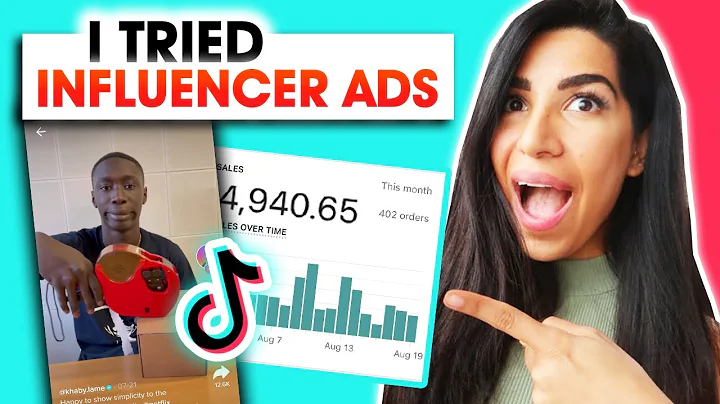Unveiling the Revenue Potential of Pre-Built Shopify Stores
Table of Contents:
- Introduction
- The Average Conversion Rate of Pre-Built Shopify Stores
- Factors Affecting Revenue in Drop Shipping
- Marketing Strategies for Driving Traffic
4.1 SEO Content Marketing
4.2 Influencer Marketing
4.3 Paid Ads
- Understanding the Niche and Target Audience
- Overcoming Competition in E-commerce
- The Importance of Perseverance and Motivation
- Building a Successful Drop Shipping Store
8.1 Investment of Time and Effort
8.2 Trying New Marketing Techniques
8.3 The Role of SEO in Driving Organic Traffic
8.4 Scaling Up to Six or Seven Figures
- Next Steps After Receiving a Pre-Built Shopify Store
- Conclusion
How Much Money Can You Make with a Pre-Built Shopify Store?
When it comes to drop shipping using a pre-built Shopify store, one of the questions that frequently arises is how much money can you expect to make? While there is no one-size-fits-all answer to this question, this article will provide insights into the factors that influence revenue, the average conversion rate of pre-built Shopify stores, and the marketing strategies that can drive traffic to your store.
The Average Conversion Rate of Pre-Built Shopify Stores
After delivering a pre-built Shopify store, access to its sales analytics dashboard is lost, making it challenging to provide an average revenue figure. However, the average conversion rate for these stores typically ranges between two to four percent. This means that out of every 100 visitors, you can expect at least two people to convert. It's important to note that the conversion rate is influenced by the quality of traffic, with U.S. traffic having higher buying power and conversion potential.
Factors Affecting Revenue in Drop Shipping
Determining the revenue you can expect from your pre-built Shopify store depends on various variables. The key determinant is the amount of traffic you can drive to your store through effective marketing strategies. Building roads that lead to your store is essential, and this requires knowledge of SEO, content marketing, influencer marketing, and paid ads. Additionally, understanding your niche, the target audience, and product demand plays a significant role in your store's revenue potential.
Marketing Strategies for Driving Traffic
To succeed in drop shipping, you need to implement effective marketing strategies to drive traffic to your website. This section explores three essential marketing techniques:
-
SEO Content Marketing: Optimizing your website content for search engines is crucial for attracting organic traffic. This includes improving on-page and technical SEO, creating new and engaging content, and acquiring quality backlinks.
-
Influencer Marketing: Collaborating with influencers can help increase brand visibility and reach a wider audience. By leveraging influencers' social media presence and credibility, you can drive targeted traffic to your store.
-
Paid Ads: Investing in paid advertising platforms like TikTok ads, Instagram ads, or Google ads can accelerate your store's growth by driving traffic and generating sales. Proper targeting and testing different ad campaigns are key to optimizing your return on investment.
Understanding the Niche and Target Audience
Having a deep understanding of your niche market and target audience is essential for drop shipping success. By knowing your audience's interests, pain points, and buying behavior, you can tailor your marketing efforts to resonate with them. Conduct thorough market research, identify your unique selling proposition, and create a compelling brand story to attract and retain customers.
Overcoming Competition in E-commerce
While competition in e-commerce can be daunting, it is also an indication of existing product demand. This article debunks the notion of oversaturation and emphasizes the advantages of entering an existing market. Having competitors means there is a proven demand for your products. It is easier to tap into an existing market and carve out a share of the pie than trying to sell a product with no existing demand or target audience.
The Importance of Perseverance and Motivation
Building a successful drop shipping store is similar to any other business venture. It requires dedication, perseverance, and continuous learning. The article emphasizes the importance of investing time and effort in learning e-commerce and drop shipping. It differentiates between two hypothetical scenarios: one where a person gives up easily and another where they are committed to learning and trying new marketing techniques. The latter scenario has a higher likelihood of achieving growth and reaching revenue goals.
Building a Successful Drop Shipping Store
This section provides valuable insights into the key aspects of building a successful drop shipping store:
-
Investment of Time and Effort: Building a business, including a drop shipping store, demands significant time and effort. Actively seeking new customers, continuously improving your marketing strategies, and staying updated with industry trends are all part of the process.
-
Trying New Marketing Techniques: It is crucial to explore different marketing techniques and platforms to find what works best for your specific niche. This could include paid media advertising, influencer collaborations, social media marketing, or email marketing.
-
The Role of SEO in Driving Organic Traffic: Search engine optimization plays a vital role in driving organic traffic to your store. By optimizing your website for search engines, producing high-quality content, and earning authoritative backlinks, you can increase your visibility and attract targeted organic traffic.
-
Scaling Up to Six or Seven Figures: While timelines may vary, the article suggests that with diligence and knowledge, it is possible to scale a pre-built Shopify store to six figures within one to two years and even reach seven figures within two to four years.
Next Steps After Receiving a Pre-Built Shopify Store
After receiving your pre-built Shopify store, it is essential to take the right steps to kickstart your marketing efforts. This article recommends following a strategic approach to marketing and provides a resource link for further guidance.
Conclusion
In conclusion, the revenue potential of a pre-built Shopify store in drop shipping depends on various factors, including effective marketing strategies, understanding of the niche and target audience, and perseverance in learning and adapting. While there is no guaranteed formula for success, with dedication, continuous learning, and investment of time and effort, it is possible to achieve significant revenue growth in the drop shipping business.
Highlights:
- The average conversion rate of pre-built Shopify stores ranges from two to four percent.
- Success in drop shipping depends on effective marketing strategies, such as SEO, influencer marketing, and paid ads.
- Understanding the target audience and niche market is crucial for driving sales and attracting customers.
- Competition in e-commerce signifies existing product demand and serves as an opportunity for success.
- Perseverance, motivation, and continuous learning are key to building a successful drop shipping store.
- SEO plays a vital role in driving organic traffic and generating sales.
- Scaling a pre-built Shopify store to six or seven figures is achievable with time and knowledge.
FAQ:
Q: How much money can I expect to make with a pre-built Shopify store?
A: The revenue potential varies based on factors such as marketing strategies, niche market, and effort invested. While there is no definitive answer, with dedication and effective marketing, scaling to six or even seven figures is possible.
Q: What marketing strategies are essential for driving traffic to a drop shipping store?
A: SEO content marketing, influencer collaborations, and paid ads are crucial for attracting traffic to your store and generating sales.
Q: Is competition in e-commerce a disadvantage?
A: No, competition indicates existing product demand and a potential target audience. It is easier to enter an existing market than introducing a product with no demand.
Q: How long does it take to see significant revenue growth in drop shipping?
A: Timelines may vary, but with continuous learning, perseverance, and investment of time and effort, significant revenue growth can be achieved within one to two years.






















